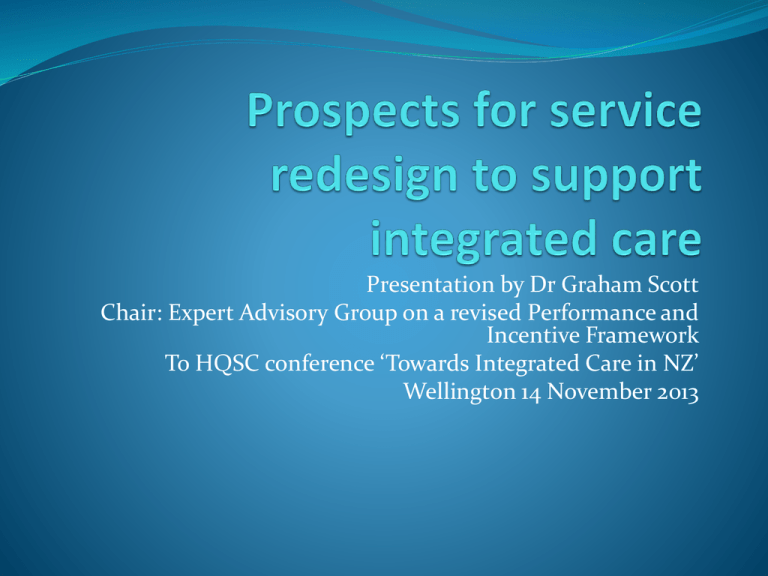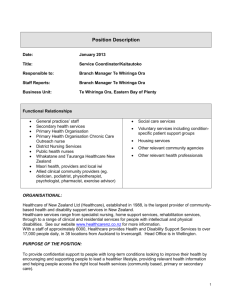Prospects for service redesign to support integrated care in New
advertisement

Presentation by Dr Graham Scott Chair: Expert Advisory Group on a revised Performance and Incentive Framework To HQSC conference ‘Towards Integrated Care in NZ’ Wellington 14 November 2013 Expert group on the performance and incentive framework Members Dr Graham Scott (chair) Prof Sir Mason Durie Vince Barry Dr Richard Tyler Geraint Martin Dr Murray Horn Dr Judith Smith TOR development of a performance and incentive framework for PHOs that will need to be accompanied by a monitoring and management programme. encouraging more patient-centred care closer to home contributing to a financially and clinically sustainable health system Take a ‘whole of systems’ approach The initial focus will be on driving performance improvement in primary care Support government priorities Sustainable / Implementable /Future proofed Align with DHB annual planning and monitoring Work thus far Expert Advisory Group have considered NZ and international experience of health performance frameworks; Identified some main elements of a potential framework for New Zealand; Reviewed the ‘straw man’ proposal by the GP Leadership Forum Holding a series of large regional workshops, and other engagements - like Tumu Whakarae - and other methods (such as web feedback), for critiquing, further developing and testing the framework it Lessons about integrated care From the UK More systematic management of chronic disease Active engagement of patients Population based approach More integrated models of care Lessons from NZ – the leading innovators are confirming the lessons of international experience Better integrated service delivery cannot be engineered from the centre nor easily duplicated Local circumstances play a large part Local leadership is essential Focus on solutions not problems Values and culture are critical – hierarchies and politics kill innovation Key conclusion is that centrally imposed performance and incentive frameworks won’t make it happen. They can set the basic requirements and provide some motivation and empowerment. But high levels of success come about from innovation, leadership, community engagement and local circumstances; and from flat inclusive organisational arrangements not hierarchies; not consultation but positive engagement and co-production Our proposed framework System level measures to assess performance across whole districts, supported by contributory measures which reflect local priorities and approaches towards system level improvement. System wide scope: DHBs, PHOs and general practice be the starting point for developing measures, but there should be rapid expansion to a wider range of health professions and services, and in time to a full range of disability and social sector services, potentially including Whanau Ora. Replace PPP measures, align with other performance systems and reduce overall compliance costs Flexibility for local initiatives to be included Levels of performance Four distinct levels of performance, from entry, to improving, to excellence to breakthrough; Assessment of performance at each of these levels should apply to each district wide health system as a whole; Assessment of performance may sometimes be judged by reaching a set target, and sometimes be judged by achieving a narrow range of variability in practice or use of resources; The range of performance within a district will be made visible by this approach, and that high performing organisations will have to work with lower performing organisations in order to lift achievement across the system. Performance indicators There to support improvement in quality, access and value Need both: consistency for the purpose of performance comparison, and tailoring to local plans and improvement activities. Combine elements of information for judgement (targets) and for exploration and improvement (tin-openers) system level measures largely nationally determined, and be predominantly used for judging performance between districts. contributory measures be largely locally determined at district level, and have a strong element of quality improvement, indicating various professional and organisational contributions to system level performance. Need to balance indicators of results and capabilities The choice of performance indicators Health outcomes are the goals but we must account for practical issues: Often not easy to measure Subject to multiple influences - some beyond the direct control of the service provider Proxies for outcomes (impacts, outputs, inputs, capability, quality) are often the best choice Poor choice of performance indicators may induce distortions to behaviours and other unintended consequences The indicators must makes sense and be owned by the providers Must be able to aggregate contributory measures up to system level Incentives • • • • • Change from pre-requisites at the base to freedoms at the top Resources attached to the framework, including the existing money associated with the PPP, should largely pass to frontline health professionals. A proportion of this should be used for capability e.g. to support professional participation in quality improvement programmes. Health professionals largely motivated by high standards of services to patients and communities Freedom of professional judgement over use of clinical resources - but within quality improvement systems -should be a key element of the incentive for high performance Triple Aim as adapted by the HQSC Governance • At a national level governance of the framework should be independent, credible, expert and responsive to consumer need, with a transparent appointment process for clinical and other essential expertise. • Options are being discussed through the workshops and through the consultation • Implementation may be through existing structures - with changes if needed – to avoid duplicating or creating new organisational structures. • At a local level alliances should agree performance and quality improvement priorities and preferred contributory measures for services within the framework. Implications for Maori health services Sends a signal for joint responsibility for health of the population across all services and stakeholders: challenges of providing high quality services for Maori are challenges for everybody across the system; Maori perspectives can feed into governance and continuing development Triple aim framework is broad, and can be inclusive of Maori approaches System wide measures broken down by ethnicity and deprivation categories to ensure that equity for Maori is an explicit lens for measures; Framework can incorporate service integration beyond core health services e.g. in Whanau Ora Contributory measures appropriate for local health needs can incorporate responsiveness to particular Maori issues Roadmap Documentation onto Health Improvement and Innovation Resource Centre website early October Draft measures and indicators on Health Quality Measures NZ http://www.hqmnz.org.nz Stakeholder engagements October-November: Christchurch ,Wellington, Hamilton, Auckland Extensive on-line conversation and feedback through MOH Final EAG advice in December – the ‘starter pac’ Implementation starts mid-2014 Please help We need to test the proposals we have come up with so far, and we need to ensure that the measures which will be used at each level are fit for purpose. Only then will we be in a position to set out an effective integrated performance and incentive framework which will help to enable the best levels of performance in health care that we can achieve











